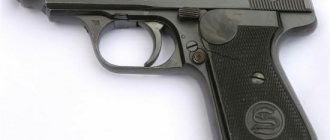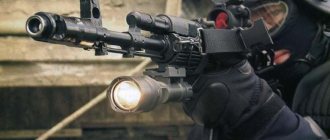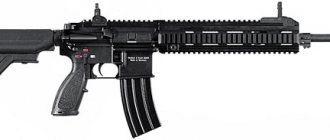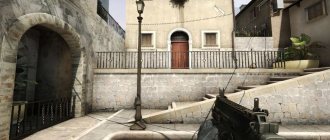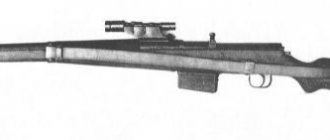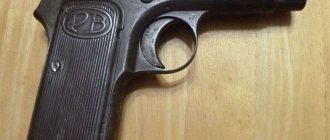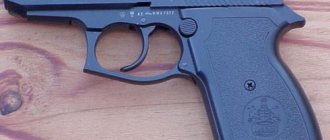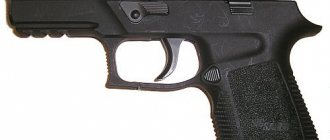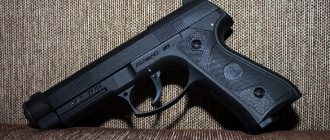Home | Weapons | Pistols | Germany | Mauser 1914 / 1934
Mauser 1914 pistol
Mauser 1934 pistol
The Mausers 1914 and 1934 are perhaps some of the most interesting compact pistols of the early 20th century. Specialists from the German company Waffenfabrik Mauser AG have created a new pistol chambered for the more powerful 7.65mm Browning cartridge based on the previously produced 6.35 mm model 1910 pocket pistols. The weapons were intended for both the police and the civilian market. The design of the Model 1914 had the largest number of protected patents for its time. The pistol has the following main differences: fastening the barrel using a locking rod; the bolt stop holds the bolt-casing in the rearmost position after all the cartridges have been used up until the magazine with or without cartridges is attached, and also serves as an automatic magazine safety and reflector; convenient manual safety on the left side of the handle, turned off by pressing a button; the trigger mechanism was covered with a plate on the left side of the frame; the barrel is almost completely open, with the exception of its lower and breech parts.
During World War I, the Model 1914 was used by the German Army as a limited standard weapon. Among the commanders, the pistol has earned a reputation as a reliable and convenient weapon. The Mauser 1914 was in great demand on the civilian arms market, both in Germany and in many European countries. During the period between the two world wars, this compact, accurate and durable pistol was widely used by intelligence agencies. It was secretly worn and used by scouts and saboteurs. The pistol was also in service with the police. During World War II, the Model 1914 was again widely used by the German military, SS, intelligence and police forces, along with the newer Model 1934. After the war, large numbers of these weapons went to the armies and of course the intelligence services of the Allies and the USSR as trophies. Compact Mausers were used until the 1970s. Currently, the Model 1914 is a collectible weapon, but thanks to its high strength and excellent quality steel, it continues to be a fully functional and effective weapon in the right hands.
The Mauser 1914 was created as a compact personal weapon, easy to handle, safe for its owner and quite effective. Automation works according to the scheme of using recoil with a free shutter. The trigger mechanism is striker-fired, single action. With the help of the rear part of the firing pin protruding from the surface of the bolt-casing, when it is held by the sear, the owner can easily determine whether the firing pin is cocked, both visually and by touch. Descent with warning. The pistol is equipped with a manual safety, which locks the cocked striker in the on position. To turn it on, you must move the safety lever to the lower position in which it is fixed. The fuse is turned off by pressing a button. In this case, the lever is released and, under the action of the spring, returns to its original position. Once all the cartridges have been used up, the bolt-casing is locked by the bolt stop in the rearmost position and released by attaching a loaded or empty magazine. If there are cartridges in the magazine, the first of them is automatically sent by the bolt-casing into the chamber.
Single-row magazine. The magazine release is located at the bottom of the handle. The weapon has good shooting accuracy - at a distance of 25 meters, the group of hits is a vertical ellipse measuring 170x70 mm. The advantages of the pistol are the very high quality of manufacturing of all parts and the quality of surface treatment, high-quality steel, high reliability, long service life, high mechanical strength of the main structural parts, shooting accuracy, and the ability to replace the barrel. The disadvantages include the rather large width and weight of the weapon for a compact pistol, the difficulty of incomplete disassembly and assembly for maintenance, the presence of many small parts, a manually controlled safety, without which it is impossible to safely carry a loaded weapon, as well as sensitivity to contamination of the trigger and the occurrence of Sometimes there are delays in firing at low temperatures.
The Mauser 1914 is a beautiful and well-made pistol. It fits well in the hand, but not very well. The small grip is not ergonomic, which was corrected in the Model 1934. There is no deep hand position, but overall the grip allows for good control of the weapon when shooting. In addition, wooden cheeks feel much more pleasant than modern plastic and rubber ones. The lack of self-cocking is partly compensated for by the manual safety switch, which is turned off by a button. The design is, of course, more complex than a simple lever that blocks the sear or striker, but it is quite functional. There are a couple of disadvantages of this system - when you turn it off, a click is clearly audible, and it’s difficult to quickly turn it off while drawing a weapon due to the small size of the button. However, in practice it is still quite convenient to turn off the fuse with such a button.
The device of the Mauser 1934 pistol
A barrel with a muzzle protruding beyond the dimensions of the weapon and thick walls can withstand high pressure. Accordingly, you can use cartridges with a large amount of gunpowder. The protruding muzzle allows it to be threaded, removing the front half of the front sight. The barrel is removable, and the operation to remove it is quite simple and quick. This design allows you to generally replace the barrel with a similar one, with the same basic dimensions, but of a different caliber, length, etc. Due to the low recoil force when firing 7.65 mm caliber cartridges, the weapon’s toss during a shot is not strong, even taking into account the high location of the bore axis above the buttplate of the handle. Accuracy is high, which is to a large extent the result of the short stroke and low trigger force. Overall the descent is pleasant. At 25 meters you can easily fit a magazine into the head of a standard military pistol target. Overall, the pistol leaves a very good impression of a well-made, robust and durable weapon. This weapon is simply a pleasure to hold and shoot.
Elite Lugers from Mauser-Werke
Home | Weapons | Pistols | Germany | Elite Lugers from Mauser-Werke
Luger pistol "Swiss" model (1970) produced by Mauser-Werke
Luger pistol "Swiss" model (1970) produced by Mauser-Werke
To assess the possibility of resuming the production and sale of Luger pistols, the American company Interarms, on the initiative of Sam Cummings, carried out deep marketing in the United States and Europe, as a result of which in 1967 a 10-year contract arose between Interarms and Mauser-Werke for the production of 100,000 Luger pistols, which should They retailed for about $160. The production of the P.08, which entered service during the Second World War, or the production of their exact copies, was impossible due to the loss of major equipment and accessories. As a result, the choice fell on the modernized Swiss model 1906/29 in caliber 9 and 7.65 mm. After purchasing the necessary equipment and tools in Bern, Mauser released these pistols in 1970 at prices of $270 and $260, respectively. However, they never became in sufficient demand and as a result their production was discontinued. Not stopping there, Mauser-Werke decided to produce so-called “anniversary” batches of Lugers, 250 of each model.
These are elite items in a superbly crafted gift case with a spare magazine, tools for disassembly and cleaning, and a modern instruction manual. Such Lugers can have excellent engraving with various inscriptions upon request of consumers. The “Swiss” model (1970), “Russian” and “Bulgarian” (1975), “Sea model” (1979), pistol-carbine 1902 (1981), P.08 and LP were produced .08 (1985). To increase the profitability of production, in 1990 Mauser began the tried and tested method of restoring old pistols from warehouses of the former GDR, as well as Bulgaria. The old stamps and plating were removed, and the new superior plating, gilding and walnut grips replacing the old plastic ones created the desired effect. Such pistols can be distinguished by modern stamps, for example “Mauser-Werke Oberndorf 1997”. Their current market value ranges from $1,000 to $1,500, depending on execution and condition.
Owner's review: “After many years of searching, I decided to buy myself a Luger. I don't like used pistols and prefer only new ones or those in very good condition. But there are also models from relatively modern manufacturers, at fairly decent prices - Stoeger or Interarms from Mauser-Werke. The first one had to be discarded, since the reviews were either very bad or very good, so I decided not to risk it, although parabellum in stainless steel is a thing. In the end, I decided to go with the brainchild from Mauser-Werke. The pistol is made on the basis of the Swiss Luger model 1906/29, produced in Germany at the Mauser-Werke plant using Swiss equipment. The pistols were produced in the 1960s in a small batch for the American market.
The difference from the original, I mean model 1906/29, not 1908, is in the shorter safety on the handle and wooden cheeks. The pistol came in a cardboard box with a cleaning rod for cleaning the barrel, a screwdriver and a spare magazine. Although on other models there is no safety on the handle and the handle is of a different, not straight, shape, this weapon is still a Luger. And the Swiss, admittedly, don’t make bad weapons. The gun is amazingly accurate and reliable - not a single delay. Although I was warned that it was impossible to shoot weak cartridges from it, as there would be problems with the operation of the automation. But it's better this way. It doesn't hurt my head that the gun will explode. When firing, it feels like you are touching the target with your finger. No pistol fits as well in the hand as the Parabellum. Cleaning and disassembling is a breeze. The coating of the gun is 5+, smooth and shiny. So if you want to buy a Luger cheap and cheerfully, I recommend it. I haven’t regretted this purchase for a day.”
Pistols
- Israel
- Spain
- Mexico
- South Korea
- Slovakia
- South Africa
- Montenegro
- Croatia
- Japan
- Norway
- Ukraine
- Vietnam
- USA
- Great Britain
- Finland
- Hungary
- Germany
- Serbia
- Switzerland
- Poland
- France
- Belgium
- Italy
- Austria
- Russia/USSR
- Brazil
- Türkiye
- Argentina
- Canada
- UAE
- Jordan
- China
- Bulgaria
- Slovenia
- Czech
Technical characteristics of the Mauser 1934 pistol
- Caliber: 7.65mm Browning
- Weapon length: 155 mm
- Barrel length: 87 mm
- Weapon height: 115 mm
- Weight without cartridges: 650 g
- Magazine capacity: 8 rounds
Pistols
- Israel
- Spain
- Mexico
- South Korea
- Slovakia
- South Africa
- Montenegro
- Croatia
- Japan
- Norway
- Ukraine
- Vietnam
- USA
- Great Britain
- Finland
- Hungary
- Germany
- Serbia
- Switzerland
- Poland
- France
- Belgium
- Italy
- Austria
- Russia/USSR
- Brazil
- Türkiye
- Argentina
- Canada
- UAE
- Jordan
- China
- Bulgaria
- Slovenia
- Czech
Mauser pistols model 1910 1914 and 1934 (Germany)
Mauser 1910 6.35mm pistol, left view.
Mauser 1910 6.35mm pistol, right view.
Mauser 1910 pistol, incomplete disassembly.
Mauser pistol model 1914 (sometimes designated 1910-14), caliber 7.65mm.
Mauser pistol model 1934, caliber 7.65mm. Option for commercial sale.
Mauser pistol model 1934, caliber 7.65mm. Variant used by the Kriegsmarine (German Navy) during World War II.
Characteristics
| Mauser 1910 | Mauser 1914, 1934 | |
| USM | single action | |
| Caliber | 6.35x16mmSR (.25ACP) | 7.65×17mmSR (7.65mm Browning) |
| Weight without cartridges | 425 g | 600 g |
| Length | 116 mm | 152 mm |
| Barrel length | 80 mm | 86 mm |
| Magazine capacity | 9 rounds | 8 rounds |
In 1909, designers of the famous weapons company Mauser Werke began developing a new pistol chambered for the 9x19mm P.Patr.08 cartridge (better known as the 9mm Luger / Parabellum), which had just been adopted for service. The design was based on an unusual automatic design with a semi-blowback, as well as the now traditional weapon layout with a detachable magazine in the handle. The first prototypes of such a pistol appeared in 1910, and its improved model, known as the Mauser 1910/12, was even produced in a small series (several hundred pistols) commissioned by Brazil. However, during development it turned out that the adopted scheme was not very successful, but if one abandoned the semi-blowback bolt and reduced the dimensions of the weapon, a good pocket pistol could be obtained. Thus, the Mauser model 1910 pistol was born, chambered for the relatively weak, but very popular in that era, 6.35mm Browning cartridge. The pistol turned out to be successful, and in 1914 the Mauser company released a slightly enlarged version of the 1910 model chambered for a more powerful 7.65mm Browning cartridge. This pistol was designated by the year of manufacture - model 1914. A significant number of pistols of the 1910 and 1914 model were used by the Reichswehr (the army of Kaiser Germany) during the First World War, and pistols were purchased both through official channels and with the personal funds of officers. In 1934, the Model 1914 pistol was slightly updated, making mostly cosmetic changes to the design, and the Mauser Model 1934 pistol was born. This pistol was used as a limited standard weapon in the arsenal of the Kriegsmarine (Navy) and Luftwaffe (Air Force) of Nazi Germany, as well as in the police and other armed forces. After the end of World War II, the production of these pistols was not resumed.
In terms of design, the Mauser pistols 1910, 1914 and 1934 have minimal differences, most of which are cosmetic. All of these pistols had automatic blowback action. The barrel is motionless when firing, but can be easily removed during disassembly. Attaching the barrel to the frame is quite unusual - using a longitudinal valley rod, inserted from the front under the barrel and passing through holes in two stops made on the lower surface of the barrel. The trigger mechanism is striker-fired, non-self-cocking (single action). The manual safety is located on the left in the cutout of the cheeks of the handle. The design of the pistol provides for a slide stop, but it can only be turned off by inserting the next magazine (it doesn’t matter whether it’s full or empty). The magazine release is located at the base of the handle. The cheeks of the handle are wooden or plastic.
Mauser m1910 6.35×16 mm
Mauser m1910/14 (Mauser m1910/14) 6.35×16 mm
The pocket pistol, Mauser M1910 model line, was produced from 1921 to 1928.
For pistol model 1910/14, serial numbers include 221800-345000 (cal. 6.35X16 mm). TTX:
| Weight, g | 425 |
| Length, mm | 116 |
| Barrel length, mm | 78,5 |
| Caliber, mm | 6,35 |
| Magazine capacity | 9 Patr. |
The following is an excerpt from https://ru.wikipedia.org/wiki/Mauser_M1910
The developers of the Mauser Werke enterprise began developing a new pistol in 1909, chambered for the recently adopted 9 × 19 mm cartridge (9 mm Luger). The basis of the automatic pistol was the semi-blowback design, which was not quite common at that time. To do this, a braking support plate was installed in the front lower part of the pistol, which held the bolt until the bullet left the barrel. The first such samples appeared in 1910, and its already improved model, labeled Mauser 1912/14, was produced in a small batch - about 200 samples. However, when it turned out that the design was not very successful, production was discontinued. Based on this model, developer Josef Niklu created a “civilian” pistol, which was in great demand. This is how the M1910 pistol was born. The M1910 was chambered for the relatively weak but common 6.35mm Browning cartridge. From 1910 to 1913, about 60,000 samples of these weapons were produced. After a slight modification in 1914, new models of this pistol appeared. Model 1910/14 is chambered for the same cartridge as the M1914 model - 7.65 Browning. These pistols were often service weapons in many organizations and not only in Germany. In 1914, about 330,000 samples were produced chambered for 6.35 mm and 500,000 chambered for 7.65 mm. In 1934-1936, pistols of the 1914 models were again slightly modified, with the handle acquiring a more rounded shape, and the magazine heel also got rid of sharp corners. The samples were designated M1910/34 for 6.35 caliber and M1914/34 for 7.65 caliber. Much fewer of these models were produced - about 30,000 in 6.35mm caliber, about 120,000 in 7.65mm caliber.
The exhibit is located in the State Museum-Reserve Tsarskoe Selo in the Sovereign Military Chamber
, the first museum in modern Russia dedicated to the First World War.
GMZ "Tsarskoe Selo" 196601 St. Petersburg, Pushkin, st. Sadovaya, building 7 Fax [email protected]
Special thanks for support and assistance: Director of the museum - Olga Vladislavovna Taratynova
Deputy Director for Scientific and Educational Work -
Bott Iraida Kurtovna
Responsible Curator of the exhibition “Russia in the Great War” in the Military Chamber -
Onoprienko Nikolai Ivanovich
Curator of the Weapons Fund of the Tsarskoye Selo State Museum -
Gleb Viktorovich Arlyuk

